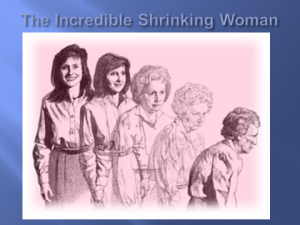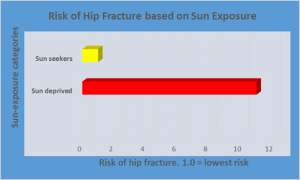Sun exposure and health… by Dr. Marc Sorenson, Sunlight Institute…
Lack of vitamin D, which is produced by sun exposure, leads to rickets, osteoporosis, osteomalacia and other bone diseases. In addition, research well after the first discovery of vitamin D has shown that vitamin D deficiency and sunlight deprivation also lead to many cancers, heart disease and multiple additional maladies. Now, as the world has modernized, the population is moving indoors, and even in the areas that are sunny throughout the year, sunlight exposure and vitamin D deficiency is increasing, both in rural and urban populations. The bones become so weakened without regular sun exposure, that the slightest movement may cause a fracture. As an example, the mother of an acquaintance of mine—a woman who avoided the sun—turned over in bed one night and broke her hip. Osteoporosis often destroys all quality or life for those who suffer it.
The importance of the sun in maintaining and producing strong bones has been known since antiquity. Dr. Richard Hobday, author of The Healing Sun, writes the following comments along with a history in an online article.[1] “Traditionally, sunlight deprivation has been linked with weak or brittle bones. One of the earliest references to this was made more than two thousand years ago by the Greek historian Herodotus (480-425 BC), who noted a marked difference between the remains of the Egyptian and Persian casualties at the site of battle of Pelusium which took place in 525 BC:
‘At the place where this battle was fought I saw a very odd thing, which the natives had told me about. The bones still lay there, those of the Persian dead separate from those of the Egyptian, just as they were originally divided, and I noticed that the skulls of the Persians were so thin that the merest touch with a pebble will pierce them, but those of the Egyptians, on the other hand, are so tough that it is hardly possible to break them with a blow from a stone. I was told, very credibly, that the reason was that the Egyptians shave their heads from childhood, so that the bone of the skull is indurated by the action of the sun — this is why they hardly ever go bald, baldness being rarer in Egypt than anywhere else. This, then, explains the thickness of their skulls; and the thinness of the Persian’s skulls rests upon a similar principle: namely that they have always worn felt skull -caps, to guard their heads from the sun.’
Herodotus, ‘The Histories’”
And here is a perhaps the transcendent study on hip fracture and sun exposure: research in Spain showed that women who were sun seekers had only about one-eleventh the risk of hip fracture as those who stayed indoors[2] (See the chart below).
That is very powerful evidence of the efficacy of sun in preventing weak bones. In stark contrast to this research are studies done on women who completely avoid the sun and suffer from osteomalacia. Osteomalacia is a soft-bone disease known as adult rickets, resulting from severe vitamin D deficiency, which deficiency prevents bone from properly mineralizing. Women who seldom go outdoors, or who are nearly always fully covered with clothing, have an extremely high incidence of osteomalacia at a very young age, even if they live in geographical areas with abundant sunlight.[3] [4] If one is never exposed to the available sun, the sun will not be able to produce its beneficial effects on the body, so one may as well live at the North Pole.
Sunbed use also is associated with stronger bones and higher vitamin D levels. An excellent study compared 50 people who used sunbeds regularly with 106 who did not.[5] The sunbed group had 90% higher vitamin D, significantly higher bone density and lower PTH levels (high PTH levels are associated with lower bone mass). The users had healthful vitamin D levels of 46 ng/ml [115 nmol/L] compared to only 24 ng/ml [60 nmol/L] for those who did not regularly use sunbeds.
Scientists at one time believed that sunlight and vitamin D were good only for preventing rickets, osteoporosis and other bone weaknesses. That belief has been supplanted by myriad research studies that show the efficacy of both sun exposure and vitamin D repletion on protection against numerous additional diseases. Nevertheless, we should never forget the extraordinary, never-changing value of sun exposure to maintaining a strong skeleton well into old age.
[1]Richard Hobday. The Healing sun: Sunlight, Brittle Bones, and Osteoporosis. http://sunlightenment.com/the-healing-sun-sunlight-brittle-bones-and-osteoporosis/. (accessed February 5, 2016)
[2] Larrosa M, Casado E, Gómez A, Moreno M, Berlanga E, Ramón J, Gratacós J. Vitamin D deficiency and related factors in patients with osteoporotic hip fracture. Med Clin (BARC) 2008;130:6-9.
[3] Sahibzada AS, Khan MS, Javed M. Presentation of osteomalacia in Kohistani women. J Ayub Med Coll Abbottabad 2004;16:63-5
[4] Al-Jurayyan NA, El-Desouki ME, Al-Herbish AS, Al-Mazyad AS, Al-Qhtani MM. Nutritional rickets and osteomalacia in school children and adolescents. Saudi Med J 2002;23:182-85.
[5] Tangpricha V, Turner A, Spina C, Decastro S, Chen TC, Holick MF. Tanning is associated with optimal vitamin D status (serum 25-hydroxyvitamin D concentration) and higher bone mineral density. Am J Clin Nutr. 2004 Dec;80(6):1645-9.
Sun exposure. By Marc Sorenson, EdD…
Endometrial cancer, also called corpus uterine cancer, is a reproductive cancer that takes the lives of many women. There are 60,050 new cases yearly from endometrial cancer and there are 10,470 deaths. Like many cancers such as breast and prostate cancer, sun exposure may have remarkable protective effects that should not be ignored.
Endometrial cancer mortality rates were found to be strongly inversely correlated with sun exposure in Dr. William Grant’s ecological studies.[1] [2] Other research, using Spanish data, found an inverse correlation between endometrial cancer mortality and sun exposure assessed by using latitude as an index of sun exposure—higher latitude means less sun exposure, which means greater cancer risk.[3] Corroborating this finding was research from Sweden; this 15.5-year study showed a 20% decrease in the risk of endometrial cancer among women who sunbathed in the summer, and a 40% decrease in risk in those who used a sunbed more than three times per year.[4] When the data was adjusted for confounding factors such as body-mass index and physical activity, the decrease in the risk of endometrial cancer was 50%!
The takeaway from this information is this: Don’t be taken in by the anti-sun cabal. Read all the facts before making a decision. And, always take care not to burn, whether in the sun or in a sunbed.
[1] Grant WB. An estimate of premature cancer mortality in the U.S. due to inadequate doses of solar ultraviolet-B radiation. Cancer. 2002 Mar 15;94(6):1867-75.
[2] Grant WB, Garland CF. The association of solar ultraviolet B (UVB) with reducing risk of cancer: multifactorial ecologic analysis of geographic variation in age-adjusted cancer mortality rates. Anticancer Res. 2006 Jul-Aug;26(4A):2687-99.
[3]Grant, WB. An ecologic study of cancer mortality rates in Spain with respect to indices of solar UVB irradiance and smoking. Int J Cancer 2007;120:1123-28.
[4] Epstein E, Lindqvist PG, Geppert B, Olsson H. A population-based cohort study on sun habits and endometrial cancer Br J Cancer. 2009;101(3):537-40.
By Marc Sorenson, EdD, Sunlight Institute…
We all know that high sunlight exposure in adults leads to higher vitamin D levels. However, a most interesting piece of research also shows that your birth month has a considerable influence on vitamin D levels. In an Italian study, it was found that those who were born in winter, rather than spring and summer, were 11% more likely to develop vitamin D deficiency later in life.[i] This is an important finding, since many diseases are related in one way or another to season of birth. For example, a greater risk of obesity risk is observed in Canadians born in winter. Nevertheless, other factors such as inactivity are more important than season of birth.[ii]
This is another study that ties sunlight to vitamin D. But the question may still be asked: Is the relationship of birth seasonality to disease due to vitamin D or sunlight, or both? Whatever the answer, sunlight is the factor that makes vitamin D, so safely soak up the sun whenever you have the opportunity, and when it is too cold or overcast, safely use a sun lamp or tanning bed.
[i] Lippi G, Bonelli P, Buonocore R, Aloe R. Birth season and vitamin D concentration in adulthood. Ann Transl Med. 2015 Sep;3(16):231.
[ii] Wattie N1, Ardern CI, Baker J. Season of birth and prevalence of overweight and obesity in Canada. Early Hum Dev. 2008 Aug;84(8):539-47.


